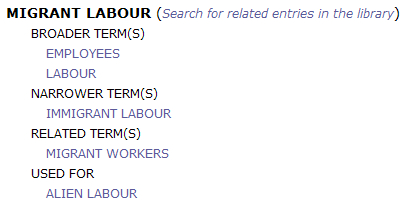thesaurus tutorial
THESAURUS TUTORIAL
THE PURPOSE OF THE THESAURUS
The thesaurus has many functions. It serves as a translator between disciplines. Disciplines sometimes use different terminology or language to describe the same idea or concept. The GWD thesaurus uses terminology specific to feminist political economy and serves as an introduction to the language of the field of social science research.
It provides a controlled vocabulary of subject headings that enables users to search the library. A controlled vocabulary is a set of standardized terms that are used to search a database. Using specific terminology in a consistent and controlled fashion results in better information searching and retrieval. We have developed our own controlled vocabulary for the GWD through consultation with module experts (specialists in a particular field) and university librarians. Furthermore, to produce a more robust list of terms, we have combined the GWD thesaurus with the controlled vocabulary specific to the Comparative Perspectives on Precarious Employment Database.
SEARCHING THE THESAURUS
The thesaurus can be searched in one of two ways. First, users can click the “Show complete thesaurus” link to see a full list of all terms contained in the thesaurus.

Second, users can search for specific terms by typing into the search box. Partial searches will work. Thus, typing in “employ” will find “employment”, “employer”, “employee”, etc.

The thesaurus is mainly organized by subject headings, identified as the bolded terms in the list. Subject heading (SH), is a term that is preferred for use in describing the underlying concept or idea and is part of the controlled vocabulary that you will need to use to effectively search the library. SHs emerge from various sources. They may be part of a list generated by module experts. They can emerge from the literature itself. They can also be modifications of existing SHs from Library of Congress Subject Headings (LCSH) or third-party vendor SHs.
For example, some controlled vocabularies may use the term “alien labour”. If users search the term “alien labour” in the GWD thesaurus they will be directed to use the term “migrant labour” instead, which is the preferred term used by the GWD and should be used to search the library resources.

WHAT’S IN THE THESAURUS
The thesaurus provides a conceptual map through the use of semantic relationships such as broader terms, narrower terms, “used for” relationships, and related terms. These semantic relationships identify theoretical connections between terms (see example below).

Thesaurus terminology is defined in the following way:
Scope note: A scope note can be thought of as a type of definition; it’s a kind of proscription about how we want people to use and understand the term.
Broader term (BT): A broader term is a term that is related to the search term, but represents a more general, or broader category. For example, Canada is a broader term to Ontario and Ontario is a broader term to Toronto.
Narrower term (NT): A narrower term is a smaller subset of the search term. For example, Ontario is a narrower term to Canada and Toronto is a narrower term to Ontario.
Related term (RT): A related term is conceptually related or linked to the search term. For example, Ontario is a related term to Alberta when the context is the country of Canada.
Use: This indicates that there is another term that should be used instead.
Used for: This indicates terms or phrases that are NOT used to index items in the library; these terms or phrases are considered synonymous with the indicated preferred term.
